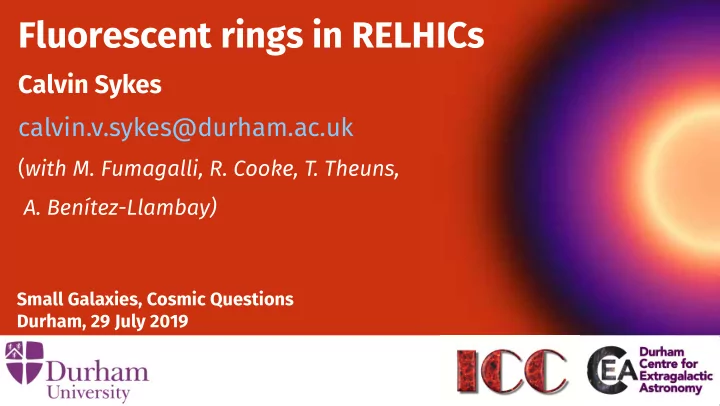

Fluorescent rings in RELHICs Calvin Sykes calvin.v.sykes@durham.ac.uk ( with M. Fumagalli, R. Cooke, T. Theuns, A. Benítez-Llambay) Small Galaxies, Cosmic Questions Durham, 29 July 2019
Gas RELHICs RELHICs: Benítez-Llambay et al, 2017 Data: A POSTLE simulatjons, Sawala et al 2016 DM
Gas RELHICs Mass too high: forms stars Just right! Mass too low: gas stripped away RELHICs: Benítez-Llambay et al, 2017 Data: A POSTLE simulatjons, Sawala et al 2016 DM
Gas RELHICs Data: A POSTLE simulatjons, Sawala et. al 2016 DM
Why does this happen?
Predicting Hɑ emission Emissivity ( = Hɑ power per unit volume) Gas in RELHICs is illuminated by the ultraviolet background (UVB) Model this interactjon using our own radiatjve transfer code* High-density, but mostly neutral Solve for hydrostatjc, thermal and ionisatjon equilbrium to determine Hɑ emissivity Highly ionised, Sharp peak at ionisatjon front... Ionisatjon front but low-density …which appears ring-shaped in projectjon *htups:/ /github.com/calvin-sykes/spherical_cloudy
Predicting Hɑ emission Gas in RELHICs is illuminated by the ultraviolet background (UVB) Model this interactjon using our own radiatjve transfer code* Solve for hydrostatjc, thermal and ionisatjon equilbrium to determine Hɑ emissivity Sharp peak at ionisatjon front... Surface brightness (= projected emissivity) …which appears ring-shaped in projectjon See Sykes et al 2019, MNRAS 487, 609-621 *htups:/ /github.com/calvin-sykes/spherical_cloudy
Predicting Hɑ emission Gas in RELHICs is illuminated by the ultraviolet background (UVB) Model this interactjon using our own radiatjve transfer code* Solve for hydrostatjc, thermal and Ionisatjon front ionisatjon equilbrium to determine Hɑ emissivity Sharp peak at ionisatjon front... …which appears ring-shaped in projectjon See Sykes et al 2019, MNRAS 487, 609-621 *htups:/ /github.com/calvin-sykes/spherical_cloudy
What can we learn from rings?
What can we learn? Observable propertjes of these rings are sensitjve to: ● Propertjes of dark matuer (CDM/WDM, cusps/cores) ● Primordial abundance of helium ● Amplitude and shape of the ultraviolet background
DM properties from size of ring Projected size of the ring is sensitjve to propertjes of DM halo Apparent size of ring is degenerate with distance and halo mass Core radius (N.B.: models shown here are illustratjve only!)
Combined constraints from Hɑ + HI 21cm Can break this degeneracy if HI profjle is also known Within a family of models, profjles are steeper for higher masses Combining ring size, brightness, and profjle slope can uniquely determine DM profjle Sykes+ 2019a, MNRAS
Primordial helium from fmux ratios Rings are expected for helium recombinatjon lines too! Comparing Hɑ and He integrated fmux gives y p to within 1% precision Compared to using H II regions: – fully in low density regime – no stellar contaminatjon Sykes+ 2019b, in prep
Primordial helium from fmux ratios Rings are expected for helium recombinatjon lines too! Comparing Hɑ and He integrated fmux Measure this... gives y p to within 1% precision Compared to using H II regions: ...to recover this value of y p … – fully in low density regime – no stellar contaminatjon ...to this level of precision Sykes+ 2019b, in prep
UVB intensity from brightness of ring UVB is diffjcult to constrain at low- z increasing due to stellar contaminatjon projected radius Star-free RELHICs provide a solutjon: Hɑ ring brightness is directly proportjonal to UVB intensity Sykes+ 2019a, MNRAS
Are they actually detectable?
Number density of rings in LG Rings are rare: expect ~few per Apostle volume Impractjcal to fjnd around MW, but surveying comparable volume much easier around other galaxies Sykes+ 2019a, MNRAS
Detection strategy Higher-mass RELHICs are bright HI emituers detectable in deep HI surveys Followup with deep imaging to rule out stellar component, then search for Hɑ with MUSE
Summary Primordial helium abundance Hɑ emission from massive RELHICs appears ring-shaped in projectjon Propertjes of rings are sensitjve to UVB, halo mass and density DM mass and propertjes UVB intensity profjle, and y p Observing a ring would allow these to be constrained Sykes et al 2019, MNRAS 487, 609-621
ENGinE Suite of 50 Mpc/h boxes at same resolutjon as EAGLE high-res (M bar =2.3x10 5 M ☉ ) EAGLE-25Mpc Aim: do RT in postprocessing and look at distributjon, propertjes of HI absorbers
Extra slides
Self-similarity in profjles Surface brightness always maximal at N HI ~10 19 cm -2 This coincides with the ionisatjon front Provides a “fjxed point” increasing despite substantjal variatjon projected Curves are for in profjle size and shape radius difgerent M 200 , UVBs, halo profjles 19
Tests of our RT code
Mass range for which rings appear
UVB slope
ENGinE halo mass function
Recommend
More recommend